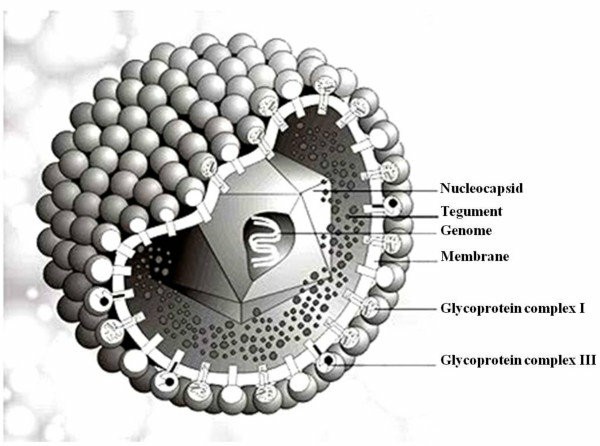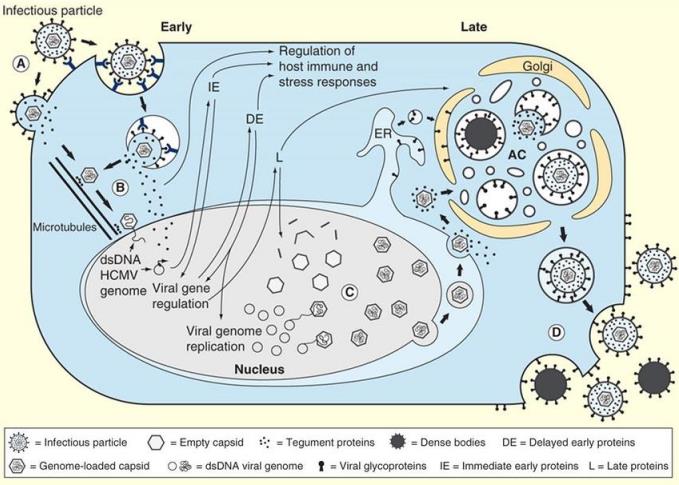Human Cytomegalovirus (HCMV) Antigens
Human cytomegalovirus (HCMV), also known as Human betaherpesvirus 5 (HHV 5) in recent papers, is a member of Herpesviridae family, Betaherpesviridae subfamily and Cytomegalovirus genus. HCMV causes the enlargement of its injected host cells (cytomegaly) and induces characteristic inclusion bodies, hence the name. HCMV can be life-threatening for newborn infants and immunocompromised ones (such as HIV patients and organ transplant recipients), but it is unnoticed in most of the health people. The infections of HCMV are mostly associated with the salivary glands, despite the fact that HCMV can be found throughout the body. HCMV is found world-widely and more than 60% of adult populations around the world were infected. This virus may cause mucoepidermoid carcinoma and other cancers such as prostate cancer.
The diameters of mature HCMV particles are 150-200 nm. Genome of HCMV consists of a double-stranded DNA with a length of approximately 230,000 bp, and is enclosed by an icosahedral capsid constructed with 162 capsomers. A protein layer named as tegument exists between the capsid and the virus envelope. The virus envelope is derived from cell membranes and contains at least eight different viral glycoproteins in the lipid bilayer, including gpUL55 (gB), gpUL73 (gN), gpUL74 (gO), gpUL75 (gH), UL100 (gM), and gpUL115 (gL). These glycoproteins play essential roles in virus entry into host cells, cell-to-cell spread, and virion maturation. gB is an essential glycoprotein that plays a crucial role in virus binding, since it is the major cell surface, heparan sulfate proteoglycan-binding glycoprotein. It also participates in viral entry, cell-to-cell spread, and cell fusion. By virtue of its abundance and ability to elicit neutralizing antibodies (abs), it has been proposed as a molecule of choice for a recombinant subunit vaccine. HCMV is sensitive to heat, low pH and lipid-dissolving agents as well as other all herpesviruses.

Fig. 1 Structure model of HCMV particle1
Figure 2 is the human cytomegalovirus life cycle. HCMV is widely distributed among host cell types. Viral entry is the result of interactions between viral gB and cellular heparan sulfate proteoglycans that culminate in fusion of the virion envelope with the cellular plasma membrane. Tegument and capsid proteins are delivered to the cytoplasm. The capsid travels to the nucleus, then the genome is delivered and circularized. The HCMV genome is expressed in a temporally coordinated and regulated cascade of transcriptional events that lead to the synthesis of three categories of viral proteins described as immediate-early (IE or a), early (E or b), and late (L or g). Late gene expression initiates capsid assembly in the nucleus, followed by nucleocapsids acquire a primary envelopment by budding at the nuclear membrane, and further mature through a de-envelopment/re-envelopment process in the cytoplasm before leaving the cell via an exocytotic-like pathway.

Fig. 2 Life cycle of HCMV2
With state-of-art facilities and years of experience in the field of antigen production, Creative Diagnostics now can provide multiple Human cytomegalovirus (HCMV) antigens and proteins to meet different requirements. Welcome to contact us for more details.
References
Landolfo, S.; et al. (2003). The human cytomegalovirus. Pharmacology & Therapeutics, 98(3), 269--297.
Mohammad, A. A. (2017). Human Cytomegalovirus : from Novel Strain, miRnas to Interplay with Breast Cancer. Karolinska Institutet (Sweden) ProQuest Dissertations Publishing, 28426593.



Share